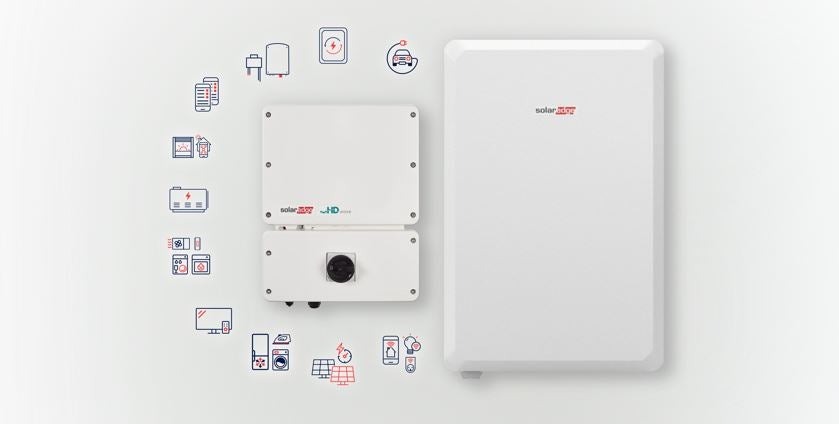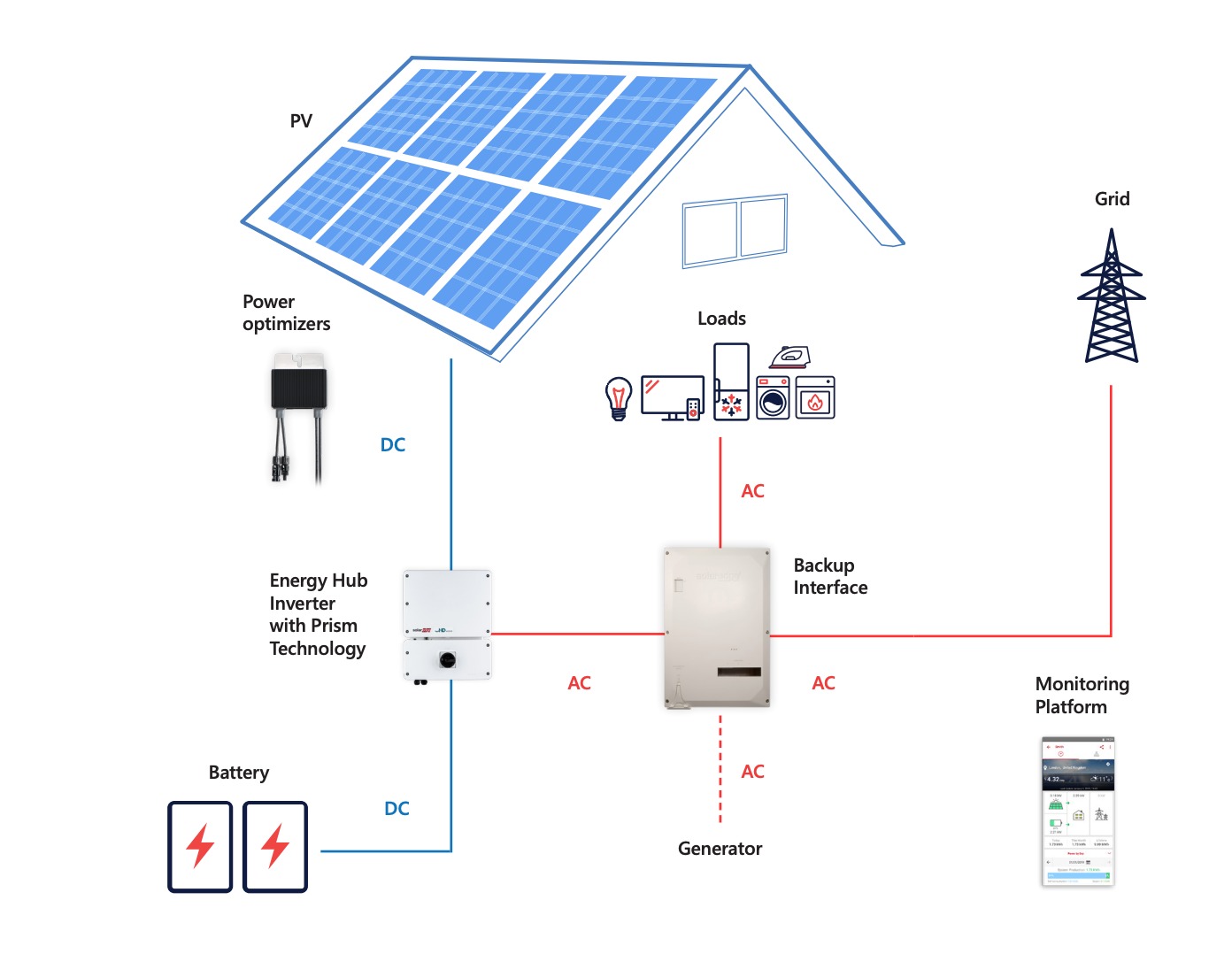
Calculate how much a solar + battery installation would cost for your home
SolarEdge has proven that even old dogs can learn new tricks. SolarEdge, best known for its power optimizers, offer an energy storage solution called the SolarEdge Energy Bank.
The Energy Bank is a 9.7 kilowatt-hour battery that can power basic electrical loads for 45 hours. It costs about $12,000 to install. The battery comes with a fantastic warranty, and because SolarEdge is a well-established company in the solar inverter space, you can trust that it will be around to honor any warranty claims you may make in the future.
Key takeaways
-
The SolarEdge Energy Bank battery is a pretty average lithium-ion solar battery that holds 9.7 kWh of electricity and can release 5 kW of power.
-
The SolarEdge Energy Bank costs about $12,000 to install, but the price will vary depending on the installer.
-
One SolarEdge Energy Bank can power basic loads like a fridge, lights, WiFi router, TV, and device chargers for 45 hours.
-
SolarEdge offers a fantastic warranty, which guarantees that the battery will operate at 70% of its initial capacity after 10 years with unlimited cycles.
How does the SolarEdge Energy Bank work?
Despite what most homeowners think, solar panels actually won’t keep your lights on during a power outage. If you want to make sure your home has power when the utility grid goes down, you need to install a solar battery.
That’s where the SolarEdge Energy Bank comes in: the Energy Bank will store the excess solar power that solar panels produce for you to use when your power goes out.
Solar panels produce direct current (DC) electricity that is sent to the Energy Bank to be stored. Then, when it’s time to discharge the battery, the stored DC electricity will flow through the Energy Hub inverter, where it is then converted into alternating current (AC) electricity that your home can use.
The Backup Interface disconnects your home from the grid during an outage and determines what electrical loads (AKA anything that uses electricity) will be powered by the battery.

Image source: SolarEdge
Right now, it's unclear what operating modes the SolarEdge Energy Bank has. It seems as though homeowners can reserve a certain amount of stored power to be saved for backup power, and the remaining amount of energy can be used to power the home when the solar panels aren't producing energy - like at night.
Homeowners can also opt for using their battery exclusively for backup power, meaning it will only provide electricity to the home in the event of a power outage.
Key features of the SolarEdge Energy Bank
There is a lot of information on a battery’s specification sheet, so we pulled out the most important performance metrics of the Energy Bank to make it a little easier for you to see if SolarEdge’s battery can meet your needs.
Specification | SolarEdge Energy Bank |
|---|---|
Usable capacity | 9.7 kWh |
Continuous power output | 5 kW |
Peak power output | 7.5 kW (10 seconds) |
Efficiency | 94.5% |
AC or DC-coupled? | DC |
Chemistry | NMC |
Usable capacity
A battery’s usable capacity represents how much electricity it can store. It also indicates how long the battery can power appliances for.
SolarEdge offers their Energy Bank battery in one size: 9.7 kilowatt-hours (kWh). 9.7 kWh is just about one-third of the average American household’s daily energy usage, so it’s a tad on the smaller side.
Most batteries on the market today are at least 10 kWh in size or more, so if you consume a lot of electricity, you might want to consider a larger battery, like the 16 kWh LG RESU Prime. Or you can always install more than one SolarEdge Energy Bank.
Continuous power output
The continuous power output tells you how much power a battery can release over a prolonged period of time. This is important because it tells you which appliances you can run with a battery.
SolarEdge’s battery comes with a continuous power output of 5 kW, which is pretty standard for most batteries on the market. With 5 kW of power, you can power your home’s most important electrical loads like lights, your refrigerator, your WiFi router, laptop, and TV. You can even power more than that, but at the very least, your essentials can be backed up.
If you’re looking to run power-hungry appliances, like an air conditioning system, you may need more than one SolarEdge battery. Or, you might be better off getting a battery that has a higher power output rating, like the Tesla Powerwall.
Peak power output
Peak power output is a little different than a battery’s continuous power output. Peak power output is the absolute maximum amount of power a battery can release for a short period of time.
In the case of the SolarEdge battery, it’s 7.5 kW for 10 seconds. This is a little higher than what you typically see for solar batteries.
The peak power output comes into play when appliances are “powering on”; appliances typically need a little more power to get up and running. So, when you’re turning on your sump pump, for example, the battery sends it a burst of initial energy to get things started.
Round-trip efficiency
When it comes to efficiency, the higher the rating, the better. Round-trip efficiency ratings tell you how much of the electricity that is sent to the battery will be available for your home to use.
We consider a round-trip efficiency rating above 90% to be solid for a battery, and SolarEdge exceeds that at 94.5%. This means a SolarEdge storage system won’t lose as much electricity when converting and storing the energy, so there’s more for your home to use.
DC-coupled
The SolarEdge Energy Bank is a DC-coupled battery, so it can be charged directly with the direct current (DC) power produced by solar panels.
When it’s time for the battery to discharge, the electricity flows from the battery to the inverter, where it’s converted to alternating current (AC) electricity that your home can use.
DC battery systems don’t have to convert the electricity as many times as AC-coupled systems, so they end up being more efficient. However, DC batteries can be more difficult to install with existing solar panels systems, so they’re better suited to be installed at the same time as the solar panels.
Read more: AC vs. DC-coupled batteries
Chemistry
The Energy Bank battery is a lithium-ion battery; more specifically, it’s a nickel manganese cobalt, or NMC, battery. NMC batteries are the most common type of lithium-ion solar battery, and for good reason. They let you store a lot of energy in a small space, and they have a long lifespan.
Despite that, NMC batteries are more susceptible to something called ‘thermal runaway’ if they’re mishandled. This means NMC batteries are more likely to overheat and catch on fire than other types of lithium-ion batteries.
The good news is, the chances of thermal runaway occurring are basically zero if the battery is installed correctly.
How long can a SolarEdge Energy Bank battery run your home?
There are two key things to look at when trying to figure out how many hours a battery can run your home: the capacity and the power rating. The capacity dictates how long and the power rating dictates what can be powered.
Based on the Energy Bank’s 9.7 kWh capacity and 5 kW power output, you can back up the essential loads in your home - your fridge, lights, WiFi router, TV, and device chargers - for 45 hours using one battery. If you start to run bigger appliances in addition to your basic loads (like a dishwasher), one battery will only be able to give you 34 hours of backup power.
It’s important to note that some appliances need way more power to run than others. Take air conditioners for example - if you decide to run an air conditioning system, you would need two batteries because they use so much power.
So, if you want to backup your entire home during a power outage, you’re going to need at least 2 Energy Banks, but most likely will need 3. If you’re fine with just powering your most important appliances, one battery will suffice.
What is the warranty for the SolarEdge Energy Bank?
SolarEdge’s performance specifications are nothing to write home about - it’s a completely standard solar battery. But, where the Energy Bank really impresses us is with their energy capacity warranty.
SolarEdge states that their battery will retain at least 70% of its initial capacity at the end of 10 years, with unlimited cycles.
70% after 10 years is pretty standard for all solar batteries; anything less than that is a red flag.
But the part about the unlimited cycles is great news for homeowners. This means that you can completely charge and recharge the battery as many times as you want, and you don’t have to worry about the capacity dropping below 70% before your 10 years is up. Most batteries have a cycle limit of around 10,000 cycles, which can shorten how long the warranty is valid for.
SolarEdge also includes a product warranty that guarantees that the battery will be free from defects in workmanship and materials for 10 years from the earlier of:
The installation date of the battery, or
12 months after the shipment of the battery from the manufacturer
Almost all solar batteries on the market today have this same product warranty.
Is the SolarEdge Energy Bank right for you?
Two big things are preventing us from recommending the SolarEdge battery. For one thing, there’s no price range to be found anywhere, so we can’t tell just yet if you’re getting a good value. It probably isn't cheaper than the price of a Tesla Powerwall.
Regardless of what the price of the Energy Bank is, most homeowners in the U.S. will not see any additional savings by buying a $10,000+ solar battery - especially if their utility offers full-retail net metering. The only way a battery could possibly lead to extra financial savings is if your utility bills you based on Time of Use rates, but they would be minimal.
Plus, there’s not a lot of information on the operating modes of the SolarEdge battery. If the operating modes are limited to what we described earlier, then this battery won’t be as useful to homeowners with Time of Use rates, which is one of the only times a battery can really provide a financial benefit.
The purchase of a solar battery will give you peace of mind during power outages, but that’s it. With that said, if energy resilience is important to you, yes, investing in a battery makes sense. So if you’re looking for a battery that can do the basics, like run your fridge during a power outage, then the SolarEdge Energy Bank could be a good fit.
If you’re looking for whole-home backup, or if you want something with more advanced operating mode features, then consider shopping around a bit more. You can also check out our guide to the best solar batteries of 2024 to find the best fit for your specific needs.
Catherine has been researching and reporting on the solar industry for five years and is the Written Content Manager at SolarReviews. She leads a dynamic team in producing informative and engaging content on residential solar to help homeowners make informed decisions about investing in solar panels. Catherine’s expertise has garnered attention from leading industry publications, with her work being featured in Solar Today Magazine and Solar ...
Learn more about Catherine Lane